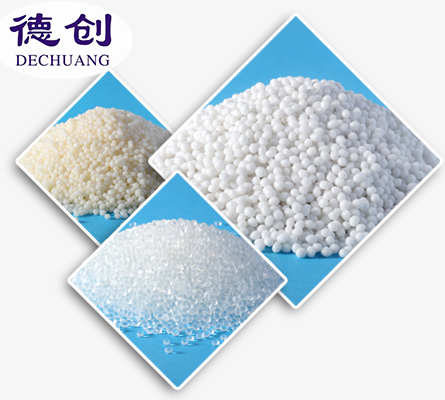Food Grade TPE Material Dechuang Chemical Industry
Contact 138 2720 9711
Product details
I. Food grade has always been a focus topic in TPE industry. This issue has been paid close attention to in the industry in the past 5 years. User consultation has also confirmed the potential demand of food grade TPE and the difficulty of TPE passing relevant food grade tests. In this paper, Ju Ye Plastic TPE, based on 12 years' understanding and comprehension of TPE industry, comprehensively discusses the issue of TPE food grade, hoping to be helpful to all purchasers. TPE discussed in this paper is a blend modified material based on SBC styrene elastomer. The transparency of TPE and TPR materials depends on the selection of components in the blending system. As long as the proper SEBS and SBS substrates are selected, the proper plastic (such as PP and PS) grades are selected, and no filler, toner, flame retardant and other functional additives are added, transparent TPE and TPR particles can be prepared by blending. However, the differences in the specific brand specifications of the components in the blending system and the different distribution ratios of the components will affect the transparency of TPE and TPR materials.
II. Different Food Grade Testing Standards for TPE
First of all, different countries or regions have different food-grade testing industry standards. Secondly, there are different testing methods for different types of food-grade contact materials. For example, the European Union's food-grade contact material testing standard is EC/1935/2004, while some countries within the European Union even have their own special testing standards. For example, Germany's food-grade testing standard is LFGB. France's is French DGCC RF 2004-64. As for the United States, FDA agencies formulate food-grade testing items and standards for corresponding materials.
III. Confirmation of Food Level Testing Standards for TPE Materials/Products
The general principle is to determine the food-grade testing standards that conform to the region according to the region where the products are exported. For example, if the products are exported to the United States, the large framework naturally conforms to FDA food-grade testing standards, and if the products are exported to the European Union, it naturally conforms to EC/1935/2004. Sometimes, the specific testing items will vary according to different products and exporting countries. For example, the TPE testing standards for food-grade contact materials commonly used in the European Union are different for dissolution testing. The main test items are hydroalcoholic acid (distilled water, 50% alcohol, 3% acetic acid, and the concentration of solvent may vary with different materials). However, LFGB in Germany has oil (olive oil) test items in addition to hydroalcoholic acid test.
Another example is the FDA food-grade testing standard in the United States. For TPE, the 21CFR177.2600 testing standard is adopted. In principle, distilled water and n-hexane are tested. However, the standard also states that n-hexane testing is mainly for TPE materials and products contacting fatty foods. In fact, in many cases, users' TPE products may only contact some non-oily and packaged foods. No hexane test is required. However, the end customers need to provide FDA inspection reports, which perplexes the TPE material and product suppliers in the industry for a period of time. At present, some TPE suppliers and users only test distilled water instead of hexane when making TPE products that do not need to contact fatty and oily food. Strictly speaking, this does not meet FDA177.2600 standard. However, some of our users who are not too harsh also accepted it. Fortunately, these products have no potential adverse effects on food and consumer safety during use. However, for some foods that come into contact with meat, rice, oily hot soup, etc., normal hexane testing must be done, which is also responsible for consumers.
IV. Feasibility and Difficulty of TPE Passing Various Food Level Testing Projects (Figure below) Sketch of Difficulty in Dissolution Test of TPE TPR for Food Contact Materials For TPE, the detection of various heavy metals and REACH(SVHC) is not a problem. It is a key testing project mainly aimed at the dissolution of small molecules, and dissolution test is mainly discussed here.
1) testing with distilled water
The vast majority of TPE can pass this item. As long as there is no too-garbage TPE compound or recycled TPE material, there is basically no problem.
2) alcohol acid test
It mainly refers to the testing of ethanol (alcohol) and acetic acid. Different countries or regions may have slightly different testing standards. The selected solvents and concentrations are different, but the testing purposes are the same. Yamamoto thinks this is mainly aimed at some beverage packaging TPE products. It is very difficult to pass this item. The selection of TPE compounds is very important. Attention should also be paid to the equipment cleaning and the introduction of additional substances during the processing of products. Of course, if the mixing system is proper, there are still a few TPE products that can pass the dissolution test of alcohol and acid.
3) Oil passing test
Mainly refers to olive oil (for LFGB in Germany) and n-hexane (for FDA in the United States and other testing standards that use this solvent, such as GB in China). TPE and TPR of these two types of oily solvents can hardly pass the test (some senior people in the industry think that n-hexane test is more difficult than olive oil test). It is said that the materials of a few foreign TPE enterprises have a hardness of over 60~70A and TPE brands that can pass the test of olive oil and n-hexane, but whether they are SBC-based TPE is not verified today.
In addition to the above two oily solvents, other national food-grade testing standards and dissolution testing solvents include n-heptane, isooctane, etc.




